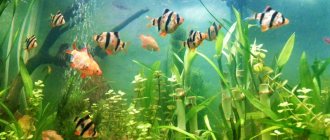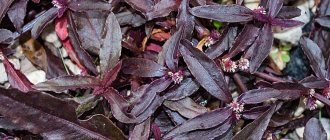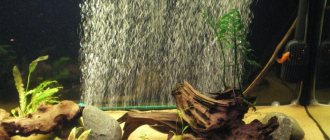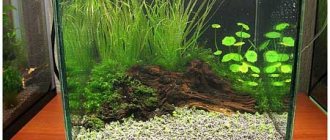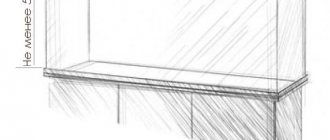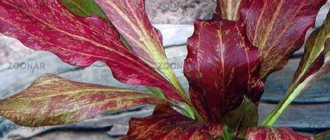Alternanthera is an ornamental foliage plant that is used for three purposes: for the design of garden and summer cottages, decorating window sills, and planting in a pond or aquarium. The article will tell you which type and variety you should choose depending on your purpose.
Variety of Alternanthera species
The genus Alternanthera, according to various sources, contains from 80 to 200 species. Some of them require high humidity and are suitable for growing in ponds and aquariums. Among them are the following species units:
- Reineka;
- sedentary;
- lilac;
- betzikiana;
- water;
- cardinal's
Low-growing species are suitable for decorating indoor window sills, including: Betsika, sweet, multi-colored. The varieties that are most often planted in open ground are the Brazilian, jagged, lovely and good varieties.
Description of the plant
The species of this plant differ in the size and color of the leaves.
The foliage is lush, the flowers are small and look unattractive against the background of the leaves. The color of the leaves, depending on the species, varies from light green to bright red. For gardeners, this plant is valuable due to its decorative value. The height of the bushes can be 25 cm. A characteristic feature of this species is that the color changes depending on the brightness of the light. The alternanthera flower is bred both for the garden and for the aquarium. Among the herbaceous plants for open ground, Alternanthera brasiliensis is distinguished. The leaves have an unusual color - green-red with an orange tint.
Among the aquarium plants, Alternanthera Reineck stands out. The leaves are green-red in color, their length is about 4 cm. The bush is fragile and brittle.
Varieties are narrow-leaved, triangular-leaved, merchant-leaved, large-leaved.
Alternanthera Reineck
Representatives of Reineck's alternanthera develop a long, creeping stem 10–25 cm long, at the end of which there are aerial roots. It is greenish-red in color. The leaves are located opposite. In shape they resemble ellipses with a sharp end 5 cm long and 2.5 cm wide.
From June to September the plant begins to flower. Inflorescences are formed in the axils of the leaves. They consist of small flowers of yellow-green or pink color.
Both when planting in the garden and when growing in an aquarium, caring for representatives of the species is not too difficult. In open ground, alternanthera needs medium-moist soil with a neutral acidity level, abundant moisture 2-3 times a week, and periodic fertilizing.
In an aquarium, Alternanthera requires regular pinching of the top of the stem to prevent the lower foliage from being shed. The plant should be planted so that its upper leaves rise above the surface of the water. The optimal water temperature is +22…+28°С. In the aquarium, the culture grows quickly, adding 10–15 cm every month.
Types and varieties
A large number of species and forms of alternanthera are combined into four groups:
- large-leaved, tall. A bright representative of Juvel - the most attractive among large-leaved plants. The leaves, especially the upper ones, have a carmine-red color. atropurpurea - dark brown leaves.
- Narrow-leaved, low-growing. The best representative of A.amoena f. rosea is a low plant with carmine-red leaves.
- Narrow-leaved and curly-leaved. Example A. paranychioi - des nana compacta height about 10 cm. Leaves are brown with a red tint. A. r. aurea major ('chroma-tclla') - leaf color is bronze-yellow.
- Broad-leaved and triangular-leaved. Representative A. versicolor - has shiny dark purple leaves with pink-red and white spots. This species is very responsive to cold weather and grows quickly.
Alternanthera rhineca
This aquatic plant is native to South America. Belongs to the Amaranth family. The root system is fibrous and grows strongly. The roots are thread-like, thin and long. The bush is very similar to long grass, the stem is erect. The leaves are arranged perpendicularly, their length is 4 cm, width 1.5 cm. The leaves have a pointed apex and taper downward. The cuttings are short. The color of the leaves is different: dark brown with a red tint above, purple below. Plant length 20-50 cm.
Alternanthera rhineca is considered a decoration for any aquarium. In summer, small yellow-green or pink flowers appear in the axils of the leaves. While underwater, the stem grows vertically upward, and at shallow depths it quickly comes out. At the same time, the plant sheds its underwater leaves. To maintain the beautiful appearance of the underwater bush, the crown of the stem must be pinched in time. After this procedure, the plant begins to branch, forming many beautiful bushes. The plant is fragile, but it grows quite quickly, adding up to 10-15 cm per month. It prefers the following conditions: hardness 2-12°, pH 6.2-6.8, temperature +24...+28 degrees. Normally tolerates a drop in temperature to +20 degrees, but growth slows down. A weekly replacement of up to 25% of the water volume is required.
Alternanthera violet
Alternanthera violet
Also Alternanthera Lilacina or Large Anther. It has an erect, elongated stem. The leaves are elongated, dark green or reddish-green above, dark red below. They are up to 5 cm long and up to 2.5 cm wide. The height of this aquatic plant is approximately 50 cm. Flowers form on the tops of the shoots.
Alternanthera sessile
Alternanthera sessile
This plant is native to tropical waters of South America and belongs to the amaranth family. The plant is not demanding in terms of its maintenance. The stems are long, the leaves are pointed, lanceolate, arranged in pairs. The color of the leaves is brownish-green, lilac-red, pink-green. When the leaves are exposed to light for a long time, they turn red with a hint of brown. The optimal temperature for uniform growth in the aquarium of this aquatic plant is +22…+28 degrees. As the temperature decreases, the growth of Alternanthera sessile slows down. It is desirable that the water be soft and slightly acidic. It is recommended to change the water 2-3 times a month. The color of the leaves depends on the intensity and brightness of the lighting: the more intense the light, the brighter and more beautiful the color. The root system is weak. Propagated by cuttings.
This species includes two subspecies:
Alternanthera sessilis var. lilacina - distributed throughout the world in warm climates. Adapts well to different living conditions - both above-water and underwater. The color of the leaves depends on the growing conditions. The most common color of the leaves is green-purple. Does not make great demands when breeding in an aquarium. Unpretentious to light intensity and water quality. When planting young shoots, they take root well. But the only condition that must be observed when growing this subspecies is ensuring the stability of the aquarium environment.
Alternanthera sessilis var. rubra. Mostly a surface subspecies. It grows at a high speed, up to 20 cm per week, and produces many leaves. When a plant is propagated in an aquatic environment, it branches greatly, some of the stems make their way to the surface of the water, where they begin to branch again. The stem and leaves have a bright ruby color. The flowers are painted in reddish shades. For flowers to appear, long daylight hours are required - up to 12 hours.
Alternanthera Betzica (Betzikiana)
Perennial herbaceous plant, 20 cm high. Erect, pointed leaves, spatulate, drooping down. There are flowers at the ends of the stems. Loves warmth, cannot tolerate temperatures below 18 degrees. This type has varieties:
- with yellow leaves
- with reds
- with green
This Brazilian alternanthera has a favorite habitat near wetlands, both in water and on land. The height of the bush can reach 50 cm. The leaves can be of a wide variety of colors: yellow, olive-red, dark red, green, light yellow, pink, and can even be variegated. When growing a plant in an aquarium, it is trimmed - this is done in order to give the bush a decorative appearance, and also so that the bush begins to sprout side shoots. Under good conditions, it begins to bloom with small pink flowers. Water temperature +24...+30 degrees, dH 4-12°, pH 6.8-7, water filtration and bright lighting are required, with daylight hours of at least 12 hours. A weekly change of up to ¼ of the volume of water with fresh water is required.
Alternanthera betzikiana green
Alternanthera betzikiana green
Prefers wetlands in Brazil, with stagnant water and quiet currents. It can grow both under water and in open ground along the banks. The leaves are green, boat-shaped, oblong. The bush is small, spreading, up to 15-20 cm high. The plant must be trimmed periodically to obtain a more decorative appearance, in order to begin the growth of a large number of side shoots. In good conditions, it begins to bloom with small pinkish flowers. It grows quite quickly. This plant can be used both for aquariums and for decorating greenhouses. Bushes are planted at a distance of 6-8 cm from each other. Prefers a temperature of +24...+30 degrees, acidity pH 6.8-7.0. When the temperature drops to +18 degrees, the plant dies. A weekly replacement of ¼ of the water in the aquarium with fresh water is required. Daylight hours are 12-14 hours.
This type of alternanther loves sunlight, so if possible you should allow sunlight to enter the aquarium. But this must be done carefully, as it can provoke the growth of algae. The brighter the light entering the aquarium, the brighter the color of the leaves.
The soil should be coarse sand or a mixture of sand and fine gravel. The thickness of the soil is at least 3 cm. Pieces of clay can be placed under the roots.
Alternanthera multicolor
Alternanthera multicolor
Alternanthera multicolor is native to the tropics and subtropics of America, Africa, Asia, and Australia. It is a perennial herbaceous or subshrub plant. A bush prone to branching at the very base. This indoor plant is easy to care for. The height reaches 25 cm. It has fragile stems. The leaves are small, lanceolate, opposite. The color of the leaves is very diverse. Depending on the brightness and intensity of the light, the color of the leaves changes color. Plants that grow in the shade have pale green leaves. It blooms with small flowers that are located in the axils of the leaves. Flowers form capitate or spike-shaped inflorescences.
Alternanthera serrata
Alternanthera multicolor
Not a species used for aquariums. The plant is native to South America. The leaves are dark purple in color and ovate or lanceolate in shape. Leaf length 8-9 cm, width 5 cm. Plant height 40-50 cm. Stems are erect, prone to branching. Small white flowers of Alternanthera serrata form a capitate inflorescence, the diameter of which is 2-2.5 cm.
Alternanthera aquatic
Alternanthera aquatic
The scientific name is Alternanthera aquatica. This is a large floating plant. Its homeland is the Amazon River basin, along the banks of rivers and swamps in Brazil, Paraguay, Bolivia, and South America. The shoots are long, about 3 meters, stretching out of the water several meters in length. Well-developed roots hold tightly to the ground or silt. The stem is hollow inside and filled with air. The leaves are green, 12-14 cm in size, evenly distributed on the stem. They have a wedge-shaped base. The petiole is about 8 cm. Roots grow under the leaves, located in the water. If the stem is damaged or torn, the plant does not drown due to its interesting structure: at the site where the leaf forms there is a kind of partition. It turns out to be a system like a float. The plant grows very quickly, therefore, it is necessary to periodically thin out the leaves. Alternanthera is quite easy to care for. But due to its enormous size, it can only be bred in very large aquariums, which is not always possible at home. It is better to plant it in a container with a clay substrate. The water should contain various trace elements, potassium, phosphate and nitrates. Water temperature +15...+28 degrees, hardness dH 2-15°, acidity pH 6.0-7.5. CO2 feeding is not necessary. Requires bright lighting. The duration of daylight should be at least 12 hours a day. In good conditions, aquatic alternanthera can bloom. The flowers are about 6 mm, with yellow stamens and pistils, measuring about 6 mm.
Alternanthera purpurea
Alternanthera purpurea
It is also called alternanthera cardinalis or cardinalis. The plant is native to the waters of South America. In reservoirs, having reached the surface of the water, it begins to grow above the water. In an aquarium, it does not produce above-water shoots. Maintaining the plant is relatively simple. It stands out clearly among other aquarium greens due to the color of its leaves: bright red below and green above. The leaves are wavy, lanceolate. The maximum height of the bush is 40 cm. Adaptation of the plant to a new place occurs in about 2 weeks, then it begins to grow quickly. Acceptable temperature is +20...+26 degrees, hardness dH 2-4°, acidity pH 6.3-7.5. It is demanding on the quality of water: it is advisable to replace ⅕ of the water in the aquarium twice a week. In low-quality old water, plant development slows down. It loves bright lighting, because the color of the leaves and the overall appearance of the bush depend on the brightness and duration of the lighting. Even in the matter of lighting, you need to know when to stop, since if the norm is exceeded, the leaves may become overgrown with algae, which can lead to the death of the plant.
Alternanthera lilac or large anther
Alternanthera lilac or large anther
It lives in quiet, low-current waters of South America. Externally it is a very beautiful plant. It stands out against the background of other greenery in the aquarium with its bright leaf color. They have an elongated elliptical shape. They are located opposite each other. The leaves are red-green or dark green on top and burgundy underneath. The leaves are 5 cm long and 2 cm wide. Flowers form in the part of the plant that is located above the water. In aquariums, the height of the anther can reach 50
Alternanthera red
It grows in wetlands, along the shores of lakes and rivers in South America. It got its name because of the bright red color of the leaves. The stem is erect, 20 cm high. The leaves have a small stalk, the shape of the leaf plate is simple, sessile. It grows slowly. Under good conditions, the plant blooms and produces above-water shoots. The flowers are small and unsightly in appearance. This plant is very beautiful with its color and stands out in the aquarium against the background of green vegetation.
Alternanthera mini
Alternanthera mini
The plant is red, low growing. This is a dwarf form of Alternanthera rhineca. Gained fame in Europe in 2007. The length of the stems is no more than 20 cm. Many side shoots extend from it to the sides. The maintenance requirements are in many ways similar to the alternanthera rhinek: moderate illumination, water temperature +22...+28 degrees. The growth rate is low. It can be propagated by shoots or by dividing bushes.
Alternanthera lovely or sweet
Alternanthera lovely or sweet
This plant is native to Brazil. Perennial herbaceous plant of the Amaranthaceae family. Grown in open ground. It has a small height, about 15-25 cm. The stem may have a few shoots on the sides. The leaves are small and oval shaped. The leaves can be green, burgundy and red-orange. The flowers are small, located at the ends of the shoots. Prefers temperatures of +18...+28 degrees, in winter +10...+15 degrees, medium-moist soil. Loves feeding with mineral and organic fertilizers. Propagated by cuttings. Alternanthera charming is a charming plant that looks great in compositions against the backdrop of green plants.
Alternanthera splendida
Alternanthera splendida
The plant is distributed along the banks of rivers, lakes and swamps in the tropics of South America. The stem is erect or creeping. Height is from 20 to 40 cm. Aquarium enthusiasts rarely breed this species. A lot of light is needed for growth and bright colors. Loves iron feeding. Temperature range +22…+30 degrees. The color of the leaves depends on the lighting power and water quality. On both sides, the leaves are pink, red or even purple-red.
Alternanthera rosea
Alternanthera rosea
This aquarium plant is native to South America. A very beautiful bush with a long stem and leaves, with a color ranging from pink-red to dark purple. Long lashes spread along the surface of the water and are pink in color. When the lashes grow, they rise above the surface of the water, and, as they grow, they begin to sink into the water under their own weight. Alternanthera, which is completely submerged, grows very slowly. This species is not very popular among aquarists. Prefers water temperature +24...+28 degrees. Tolerates temperatures down to +20 degrees, while growth slows down. Needs periodic refreshment of water.
Alternanthera garden, form “Osiris”
The material for selection was collected in the tropics of Brazil. The stem is erect, long, herbaceous, green. The weak root system consists of one clump of white thin roots. The leaves are simple, petiolate, arranged oppositely. Petioles are shorter than leaves. The color of the leaves is different - the top is soft green with a yellow coating, the bottom is green, sometimes with a crimson coating. The length of the leaflet has a ratio of 2:1 to the width.
Alternanthera sessile
Representatives of the species have an elongated stem 10–25 cm high, which grows straight. The leaves are opposite and can be located simply on the stem or grow on short petioles. The flowers are axillary. They form on shoots that are located above the surface of the water.
Since this species has a weak root system, it should be replanted only when absolutely necessary. The recommended temperature for growing alternanthera is +22…+28°C.
In addition to the aquarium, the sessile species can be grown in a greenhouse where high humidity is maintained.
This variety has two subspecies: with green-purple foliage - Alternanthera sessilis var. Lilacina and with ruby - Alternanthera sessilis var. rubra.
Alternanthera betzikiana
Decorative crop with a height of 20 cm. The stem grows vertically. The bottom has pubescence. Leaves are lobe-shaped with pointed ends. They can be painted in yellow, red, green shades. Flowers are formed at the ends of shoots or leaf axils. Flowering occurs only with good care and high humidity.
This species is very thermophilic. When the temperature drops below +18°C, the plant dies. The culture is suitable for growing in an aquarium and in open ground. In the garden it can grow in well-moistened nutrient soils. Soil that is too clayey is not suitable for growing it.
When kept in an aquarium, it requires maintaining the following microclimate: temperature - +24...+30°C, water acidity - 6.8-7 pH, water hardness - 4-12°, daylight hours - 12 hours, lighting - bright.
Planting and propagation
Priming
In an aquarium, the soil is not so important - usually you buy ready-made mixtures that are already intended for aquarium plants. But adding coarse sand has a good effect on plant growth.
Reproduction
There are two ways to grow a new plant:
- seed;
- vegetative (cuttings and division of an old bush);
The seed method is labor-intensive, because quite often alternanthera does not produce flowers. The second method is most widespread.
Cuttings - Cuttings are taken in advance in the fall. And they plant them in the ground. The container must be covered with plastic wrap and placed in a bright place without direct sunlight. Dig the cuttings up to the first leaf, provided that the length of the workpiece must be at least 8-10 cm and have 8 leaves. Next, you need to water the soil and ventilate. When the first new leaves appear, the film is removed from the container. As soon as it is clear that the cuttings have begun to actively grow, the tops of the shoots need to be pinched. This will promote the appearance of side shoots. The preparations can take root within 8-10 days. At the end of spring - from May, when night frosts stop, the plants are transplanted into open ground. To obtain a more lush and beautiful bush, several seedlings are planted in one hole. If you want to grow a plant indoors, then select a small pot for the seedlings.
When propagating Alternanthera in aquarium conditions, the torn stalk is simply left to float on the surface of the water. After a short period of time, roots will appear, and then the bushes can be planted in the substrate.
Alternanthera aquatic
This is a large plant that floats in the wild in the Amazon and in the waters of South America. It has very long shoots that reach 3 m. They can rise several meters from the water. The stem of this alternanthera is empty inside. The leaves are large, 12–14 cm long. The leaf blades are green. They grow on petioles 8 cm long. Under good conditions and care, the plant produces small flowers.
Due to its large size, aquatic alternanthera can only be grown in large aquariums or in ponds.
Optimal microclimate for plant growth: temperature - +15...+28°C, water pH level - 6-7.5, hardness - 2-15°, bright lighting, daylight hours - 12 hours.
Alternanthera cardinalis
Another name for this species is purple. In the wild, this plant grows in bodies of water and forms emergent shoots. When planted in an aquarium, it prefers to grow exclusively under water.
The plant attracts attention with the beautiful color of its leaves. Its upper leaf blades are red and the lower ones are green. In addition, the leaves have a beautiful wavy shape.
The cardinal alternanthera reaches a height of 40 cm. The optimal microclimate when growing in an aquarium is: temperature - +20...+26°C, water acidity - 6.3–7.5 pH, water hardness - 2–4°. The aquarium must be placed under bright lighting, otherwise the leaves will lose their decorative coloring.
Alternanthera brasiliensis
An erect, spreading herbaceous plant that in the wild grows up to 3 m. In cultivation, its height does not exceed 1 m. The stems are red, green, purple. The leaves are 1–10 cm long and 0.7–5 cm wide. They are usually colored in purple, red-violet shades. Small cream flowers form in the axils of the leaves.
In addition to being used in ornamental gardening, Alternanthera brasiliensis is used as a medicinal plant. Antiviral and antidiarrheal drugs are made from it.
Pests and diseases
When watering intensively, the plant suffers from gray mold
Treatment methods:
- moderate watering;
- pruning diseased branches;
- soil replacement;
- compliance with temperature conditions.
Spider mite infestation
Treatment methods:
- pruning diseased branches;
- wiping flowerpots and window sills;
- plant disinfection.
Aphid invasion
Treatment methods:
- disinfection with chemicals. (insecticide).
Popular varieties of alternanthera
Almost every variety of alternanthera has interesting forms or varieties. We invite you to get acquainted with some that deserve the most attention.
Little Ruby. This plant grows small bushes no more than 40 cm high. They branch and spread well, so the crop is wider than it is tall - 60 cm. Due to this appearance, the variety is often used to decorate an area as a ground cover plant. The flower is characterized by good frost resistance. It is valued for its beautiful foliage color. The lower leaf blades of the plant are ruby red.
Purple Knight. Representatives of this variety grow up to 50 cm in height and 20–30 cm in width. Its leaves are dark purple above and bright purple below. The flowers are small, white, and have no decorative value. “Purple Knight” is actively used in landscape design - it is planted as an accent plant in container compositions.
If you need to choose a plant with yellow foliage, then you should choose varieties Aurea, Kuntzii. The varieties Juvel, Paronychioides, Royal Tapestry, Rubra have red leaves, Rosea has pink leaves, and Amabilis has green leaves. When choosing variegated forms, you should pay attention to Ficoidea, Tricolor.
To grow any type or variety of alternanthera, it does not require much time and effort. To maintain a decorative appearance, the leaves need bright lighting. Flowering, normal growth and development of the crop can be achieved by providing warm temperatures and high humidity.

